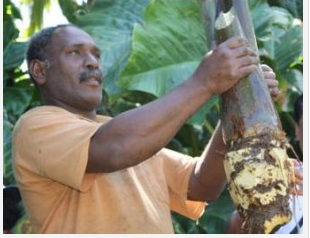Giant swamp taro (Cyrtosperma chamissonis) is a native plant of the Philippines that has dozens of varieties thriving on most of the tropical islands in the Pacific. Giant swamp taro is grown and harvested in small patches for its underground tubers, called corms.

Swamp taro corms are prepared in several ways, from roasting to grating to baking the corm whole. The corm should be eaten or preserved within two days of harvesting, and properly managed gardens can produce them year-round. The young leaves of giant swamp taro are sometimes eaten by islanders as a vegetable, and the stalks produce fiber used in weaving.
Giant swamp taro is more abundant on Pacific atolls than its better-known cousin, the taro (Colocasia esculenta), but it is much less commercially available. Its traditional cultivation is labor intensive and dependent upon a consistently saturated environment, which makes it practical to grow only in small, marshy plots.
Swamp taro is vulnerable to pests and highly perishable, making it not commercially viable. But Atoll farmers often grow giant swamp taro as part of complex polycultures, in the shade of larger trees. This helps the plants grow faster and healthier, and also helps minimize pests and diseases, which often damage swamp taro monocultures.
Researchers consider the potential of giant swamp taro to be largely untapped, partly because it is not often studied by researchers and techniques for improving the plant’s cultivation have not been developed. While the viability of export is very limited, the giant swamp taro may play a key role in feeding the inhabitants of dozens of Pacific islands.
By Isaac Hopkins

Danielle Nierenberg, an expert on livestock and sustainability, currently serves as Project Director of State of World 2011 for the Worldwatch Institute, a Washington, DC-based environmental think tank. Her knowledge of factory farming and its global spread and sustainable agriculture has been cited widely in the New York Times Magazine, the International Herald Tribune, the Washington Post, and
other publications.
Danielle worked for two years as a Peace Corps volunteer in the Dominican Republic. She is currently traveling across Africa looking at innovations that are working to alleviate hunger and poverty and blogging everyday at Worldwatch Institute’s Nourishing the Planet. She has a regular column with the Mail & Guardian, the Kansas City Star, and the Huffington Post and her writing was been featured in newspapers across Africa including the Cape Town Argus, the Zambia Daily Mail, Coast Week (Kenya), and other African publications. She holds an M.S. in agriculture, food, and environment from Tufts University and a B.A. in environmental policy from Monmouth College.








